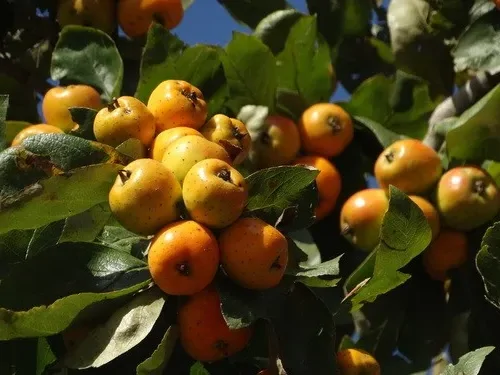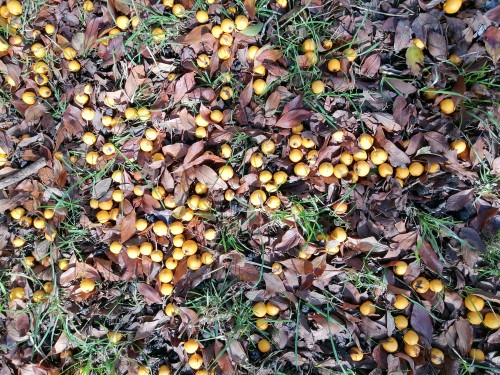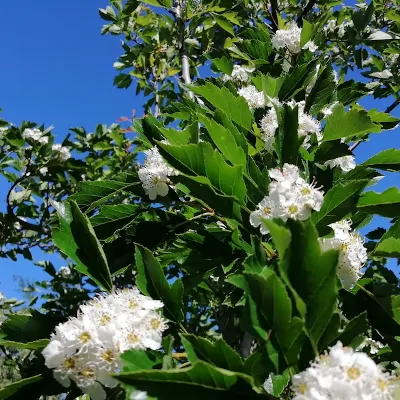Mexican hawthorn, known as "tejocote" (Crataegus mexicana), is a small fruit-bearing tree native to Mexico and Central America. It has a variety of uses and benefits, both in traditional medicine and in culinary applications.
Uses of Mexican Hawthorn (Tejocote)
-
Culinary Uses:
- Traditional Mexican Dishes: Tejocote is a key ingredient in traditional Mexican cuisine, especially during the holiday season. It is commonly used in ponche, a warm fruit punch served during Christmas celebrations. The fruit is boiled with other fruits, spices, and sweeteners to create a flavorful drink.
- Candy and Preserves: Tejocote is often candied or used in preserves and jams due to its sweet and tart flavor. It's also a component of some Mexican candies.
- Pickled: The fruit can be pickled and served as a tangy condiment or snack.
-
Medicinal Uses:
- Respiratory Health: In traditional Mexican medicine, tejocote is used to treat respiratory conditions like coughs and colds. It is believed to help clear congestion and soothe the throat.
- Digestive Aid: The fruit is sometimes used as a digestive aid, helping to alleviate issues like constipation and indigestion.
- Cardiovascular Health: Some traditional uses of tejocote include its application in promoting heart health. It is believed to help regulate blood pressure and improve circulation, similar to other hawthorn species known for their cardiovascular benefits.
-
Weight Loss Supplements:
- Tejocote root has gained popularity as an ingredient in weight loss supplements. It is marketed for its potential to reduce appetite and promote fat loss. However, caution is advised, as the effectiveness and safety of these supplements can vary, and they should be used under medical supervision.
Benefits of Mexican Hawthorn (Tejocote)
-
Rich in Nutrients:
- Tejocote is a good source of vitamins, particularly vitamin C, which supports the immune system. It also contains minerals like calcium and potassium.
-
Antioxidant Properties:
- Like other hawthorn species, tejocote is rich in antioxidants, which help protect the body from oxidative stress and inflammation.
-
Supports Heart Health:
- The fruit's potential cardiovascular benefits, such as improving blood flow and lowering blood pressure, contribute to heart health.
-
Digestive Health:
- Due to its fiber content, tejocote can support digestive health by promoting regular bowel movements and preventing constipation.
-
Traditional Healing:
- Beyond its physical health benefits, tejocote holds cultural significance in Mexican traditional medicine and is often used in remedies passed down through generations.
Precautions
- While tejocote has many traditional uses, it should be consumed in moderation. The seeds of the fruit contain amygdalin, which can release cyanide when metabolized. Therefore, it's important to avoid eating the seeds in large quantities.
Mexican hawthorn is valued both for its culinary versatility and its potential health benefits, making it a significant plant in Mexican culture.
Propagating Mexican hawthorn (Crataegus mexicana, or tejocote) from seed can be a rewarding process, though it requires patience and attention to detail.
Here’s a step-by-step guide:
1. Harvesting the Seeds
- Fruit Collection: Collect ripe tejocote fruits from a healthy tree, usually in late autumn or early winter.
- Extract Seeds: Cut open the fruits to extract the seeds. Each fruit typically contains a few seeds.
- Seed Cleaning: Remove any remaining fruit pulp from the seeds by washing them thoroughly. This helps prevent fungal growth.
2. Stratification (Cold Treatment)
- Why Stratification?: Tejocote seeds require a period of cold stratification to break dormancy and encourage germination. This mimics the natural winter conditions the seeds would experience in the wild.
- Cold Stratification Process:
- Soak the Seeds: Place the seeds in water for 24 hours to soften the seed coat.
- Prepare a Medium: Mix equal parts of moist sand, peat moss, or vermiculite in a plastic bag or container.
- Bury the Seeds: Place the seeds in the moist medium, ensuring they are well-covered.
- Refrigeration: Seal the container and place it in the refrigerator at a temperature of 0-5°C for 2-3 months (8-12 weeks). This cold period is essential for successful germination.
3. Sowing the Seeds
- After Stratification: Once the stratification period is over, remove the seeds from the refrigerator.
- Prepare Pots: Fill pots or seed trays with a well-draining soil mix, such as a mix of potting soil and sand.
- Sow the Seeds: Plant the seeds about 1.25 cm deep in the soil. Water the soil lightly to ensure it’s moist but not waterlogged.
- Germination Conditions:
- Temperature: Keep the pots in a warm location with temperatures around 20-25°C.
- Light: Place the pots in a spot with bright, indirect sunlight.
- Humidity: Cover the pots with a plastic dome or plastic wrap to create a humid environment, which helps with germination. Ensure good air circulation to prevent mold growth.
4. Caring for Seedlings
- Watering: Keep the soil consistently moist, but avoid overwatering. Allow the top layer of soil to dry slightly between waterings.
- Germination Time: Germination can be slow, taking several weeks to a few months. Be patient!
- Transplanting: Once the seedlings have developed a few sets of true leaves and are large enough to handle, transplant them into individual pots with well-draining soil.
5. Planting Outdoors
- Acclimatization: Before planting the seedlings outdoors, harden them off by gradually exposing them to outdoor conditions over a period of 1-2 weeks.
- Site Selection: Choose a sunny location with well-drained soil. Mexican hawthorn trees prefer slightly acidic to neutral soil.
- Spacing: Space the trees about 5-7 meters apart, as they can grow to be quite large.
6. Ongoing Care
- Watering: Water the young trees regularly during the first few years to establish strong roots. Afterward, they become more drought-tolerant.
- Mulching: Apply mulch around the base of the tree to retain moisture and suppress weeds.
- Pruning: Prune the tree to shape it and remove any dead or damaged branches.
Tips for Success
- Patience is Key: Tejocote seeds can take several months to germinate, and the young trees grow slowly in their early stages.
- Protection from Pests: Protect the seedlings from pests like birds and insects that may damage them.
By following these steps, you can successfully propagate Mexican hawthorn from seed and eventually enjoy the beauty and benefits of this unique tree.


